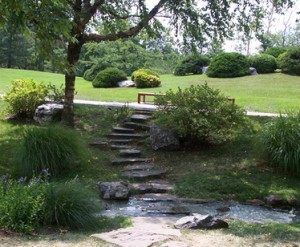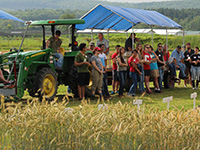Home | Unit 1
Overview
In this activity, youth will see themselves and others in context of a whole system
their relationships with other parts, and how interactions among each element works as a network rather than hierarchies. Using a Mind Map, youth will use the garden to illustrate the elements within its system, and the impacts that people and climate change have on each other and other elements in the garden.
Skill Level
Beginner/Intermediate/Advanced
Learner Outcomes, Youth will:
- Understand systems thinking, its benefits and how it applies to various systems.
- Understand a sense of place within a system.
- Recognize how systems thinking applies to sustainable eco-systems and gardens.
- Identify and explain how developing habits of systems thinking in managing gardens and landscapes can support environmental stewardship and a sustainable community.
- Identify ways to mitigate and adapt to climate
Education Standards
- NS.K-4.3 Life Science: Organisms and environments
- NS.5-8.3 Life Science: Populations and Ecosystems; Diversity of Organisms
- NS.9-12.3 Life Science: Behavior of Organisms, Interdependence of organisms, organization in living systems
Success Indicators
Understand systems thinking, its benefits and how it applies to various systems.
Life Skills
Critical thinking, resiliency, healthy living choices
Time Needed
50 minutes; extra time for Intermediate Level Variations
Materials List: Ball of yarn, newsprint/ flip-chart size paper, markers, handout, scrap paper, makers, pens or pencils.
Youth Handouts
- Forest Ecosystem
- Mind Map: What Does Systems Thinking Look Like in the Garden
- Habits of a Systems Thinker (for Leaders and intermediate/Advanced Skill Level participants)
Leader Handouts
Space
A garden space for observation and indoor or outdoor tables and chairs for writing and drawing.
Suggested Group Size
12-15 or more
Acknowledgments
Portions adapted from Cornell Garden-Based Gardening in a Warming World, Seeds of Change and Youth Corps.
Introduction
Systems thinking considers the creation, analysis, and resolution of issues that arise from complicated forms of interaction in systems. Different parts of a system are so interconnected that if we alter one part of a system it will change other parts. Systems thinkers focus on wholes rather than on parts.
In this activity, youth will see themselves and others in context of a whole system, their relationships with other parts, and how interactions among each element works as a network rather than hierarchies. Using a Mind Map, youth will use the garden to illustrate the elements within its system, and the impacts that people and climate change have on each other and other elements in the garden.
Mind mapping is a method of brainstorming. It relates to the way our brains work by linking thoughts and making connections with one idea leading into another. This activity is an effective way to reflect on interactions of elements within a living system and open the discussion and how further exploration in methods of sustainable solutions.
Opening Questions
- How do you see yourself and others as a part in the world as a whole system?
- As part of a system, what is your connection to nature, people, problems, and events?
- How might climate change affect a system (such as a garden)?
- What can we do to keep our garden system healthy and sustainable, in extreme weather and continued changes in climate?
Background Information
Refer to Thinking About Systems: 12 Habits of Mind by Linda Booth Sweeney. Consider definitions of “systems” and “systems thinker”; refer to “Habit of a System Thinker” handout to introduce systems thinking, watersfoundation.org
Before the Activity: Gather materials for the activities, set up the room for whole and small group work. Leader will prepare by reading background information and review Leader Handouts.
Let’s Do It!
Explain that we will reviewing what we know about eco-systems and be learning systems thinking. We will brainstorm and design a Mind Map to illustrate how you see yourself within that system and connected to other parts of that system.
Ball of Yarn Interconnections
- To introduce the concept of Systems Thinking, start with this icebreaker to prompt a discussion around interconnectedness.
- Form a circle with your group and have on hand a ball of yarn. Give the ball of
 yarn to one person who is willing to begin by stating a challenge or problem related to climate change (ex: extreme weather, extinction of species, food insecurity).
yarn to one person who is willing to begin by stating a challenge or problem related to climate change (ex: extreme weather, extinction of species, food insecurity). - The first person keeps hold of the end of the yarn ball and tosses the ball to another group member, who then shares a climate change challenge or problem that relates to the previous one described.
- Continue this pattern until everyone in the circle has shared.
- Note the interconnected web that has been formed as the relationships among challenges or problems emerge.
Recognizing Systems
- Distribute the Forest Eco-System handout to review prior knowledge and ask: What do we see when we look at a forest? (trees, plants, soil, water, birds, animals, sometimes people and more). How do you see each of these elements relating to each other? What positive and negative influences might you see these elements have on each other?
Mind map
- Explain that in the same way a forest has its own eco-system, so does a garden. Describe the activity: we will be brainstorming in small groups of 4 to 5 people and designing a Mind Map that shows different elements in the garden and how they relate to each other.
- Take a few moments to go outside to observe a garden or landscape and record on scrap paper, the elements they see (plants, soils, birds, etc.).
- Have the small groups return to a space with tables and pass out newsprint/ flip-chart size paper, marking pens and the Mind Map: What does Systems Thinking look like in the garden? Have each group select someone to do the writing for the group.
- Using the leader Mind Map: What does Systems Thinking look like in the garden? handout as an example, model how their Mind Maps could look like.
- Have each group design their own Mind Map on newsprint or larger paper, using the Mind Map: What does Systems Thinking look like in the garden? handout as a visual starting point and to draft notes on.
- Identify observations of the elements they just made out in the garden, and how climate change and people influence the elements in the garden’s system.
- Draw lines to and from each element illustrating which elements have relationships and interactions with each other and write any connecting thoughts on those lines.
- Explain we will be adding more to our Mind Maps after the next discussion.
Taking it a Step Further: Being a Systems Thinker in the Garden
- In observing a Systems Thinking approach, we can picture how different parts of a system are so interconnected that if we alter one part of a system it will change other parts. This allows us to ask the important questions that will help us better understand the garden system. For example: What happens to the soil and plants when there are long periods of drought or wet weather? What happens to the plants and animals as soil health and water quality change? What happens to beneficial insects when pollinating plants die off due to inconsistent weather?
For Intermediate/Advanced Skill Levels
Explore and apply the topic further with the Garden Clinic- Why System Thinking Matters and Thinking Deeper: Discuss activities in Variations.
Talk It Over
Share
Each group will share their Mind Maps in a whole group discussion.
Reflect
Why does being a systems thinker matter in our everyday lives and gardening practice?
Generalize
For youth interested in or need an introduction to Systems Thinking and its role in sustainable eco-systems, changes in the weather provide opportunities to observe the growth and development of living things and their relationships to each other. Spring inspires an awakening of the senses, and the intellect follows with a natural desire to learn. This is an excellent time to introduce the concept of connections between plants, animals, people, and climate.
Apply
How can we be systems thinkers in in our everyday lives and gardening practice?
Terms
- Albedo: the measure of how much light that hits a surface is reflected without being absorbed.
- Microclimates: the climate of a very small or restricted area, especially when this differs from the climate of the surrounding area.
- Phenology: the study of cyclic and seasonal natural phenomena, especially in relation to climate and plant and animal life.
- Sustainability: preventing the reduction of natural resources in order to maintain an ecological balance.
- Systems Thinking: paying attention to interrelationships, patterns, and dynamics as well as to the parts.
Variations
The following activities are recommended as a way of introducing students to the basics of garden ecosystems and the importance of seasonal events.
 Signs of spring. Learn about how climate change affects developmental changes (phenology) and the unfolding of seasonal cycles. Discuss how plants and animals awaken from winter dormancy and hibernation, reproduce, grow, and interact with their environment and other species.
Signs of spring. Learn about how climate change affects developmental changes (phenology) and the unfolding of seasonal cycles. Discuss how plants and animals awaken from winter dormancy and hibernation, reproduce, grow, and interact with their environment and other species.
- Start a multimedia garden journal. (Modes of learning: observing, thinking, feeling, creating). Go out in the garden and sit quietly. What do you see, hear, feel, smell? Take notes, take photos, draw pictures, make recordings of sounds. Collect in individual journals or make an electronic compilation through Moodle or other sharing format.
- Identifying microclimates (observing). On an early warm spring day, go out for a walk and observe different microclimates. Where is it warmer? Where is it cooler? Are there any north facing slopes that still have snow? Are there any south facing brick walls that have bulbs blooming next to them? Feel the surfaces of the ground with bare feet if possible. Compare a black parking lot to a light-colored paved surface. Compare pavement to grass. Discuss albedo. Record observations in journals.
Intermediate/Advanced Skill Levels: Garden Clinic- Why System Thinking Matters
Use the Habits of a Systems Thinker handout, ask youth to reflect on the Mind Map they just created. Ask them to add ideas and processes that help promote sustainability in the garden (ex: composting, using organic matter, harvesting rainwater).
- Ask one or more volunteers to briefly describe to the whole group a specific challenge or problems that occur in the garden (insects, diseases, invasive species, drought)
- Break up into teams to practice systems thinking in examining the challenge(s) or problem(s) and identifying potential strategies to address the challenge(s) or problem(s).
- Encourage teams to review the systems thinker bullet points in their efforts to identify the connections and impacts that solutions might have – including potential effects that might not be obvious at first.
- For example, using chemical herbicides may successfully kill a noxious invasive species but also the beneficial insects including pollinators that converge on it and nearby plants.
- Systems thinking requires being a detective who asks good questions to ascertain connections. Some groups may find drawing a simple diagram or map helps explore links between components, actions and potential impacts.
Advanced/Intermediate Skill Levels: Thinking Deeper
Expand the activity to include a discussion on the characteristics of a Systems Thinker:
- Sees the whole: interprets the world in terms of interrelated “wholes” or systems, rather than as single events, or snapshots.
- Looks for connections: tends to look for connections among nature, ourselves, people, problems, and events.
- Pays attention to boundaries: knows that systems are nested and how you define the system is critical to what you consider and don’t consider.
- Changes perspective: changes viewpoints to increase understanding, knowing that what we see depends on where we are in the system.
- Looks for things that slows down cause and effects (carbon dioxide)
- Reflects on one’s own assumptions about how the world works and how that may limit thinking.
- Anticipates unintended consequences: traces cause and effect asking: “what happens next?”
- Looks for change over time: sees today’s events as a result of past trends and an indication of future ones.
- Sees “self” as part of the system: looks for influences from within the system, focusing less on blame and more on how the structure (or set of interrelationships) may be influencing behavior.
- Embraces and holds the tension of paradox and ambiguity, without trying to resolve it quickly.
- Finds leverage: knows that solutions may be far away from problems and looks for areas of leverage, where a small change can have a large impact on the whole system.
- Watches for win/lose attitudes: in situations of high interdependence dichotomous views usually make matters worse.
This listing is from Gardening in a Warming World: A Climate Smart Gardening Course Book, 2018.Adapted from Thinking About Systems: 12 Habits of Mind by Linda Booth
Learn More
- Cornell Garden-Based Learning
- Gardening in a Warming World: A Climate Smart Gardening Course Book, 2018.
- Yellowstone study, wolves change rivers, Yellowstone National Park Trips
- Wolves, rivers, systems thinking, and trophic cascades, The Ecologist
- Teach Systems Thinking. InTeGrate
References
- Thinking About Systems: 12 Habits of Mind by Linda Booth Sweeney
- Habits of a System Thinker, Waters Center for Systems Thinking
- Gardening in a Warming World: A Climate Smart Gardening Course Book, 2018.









